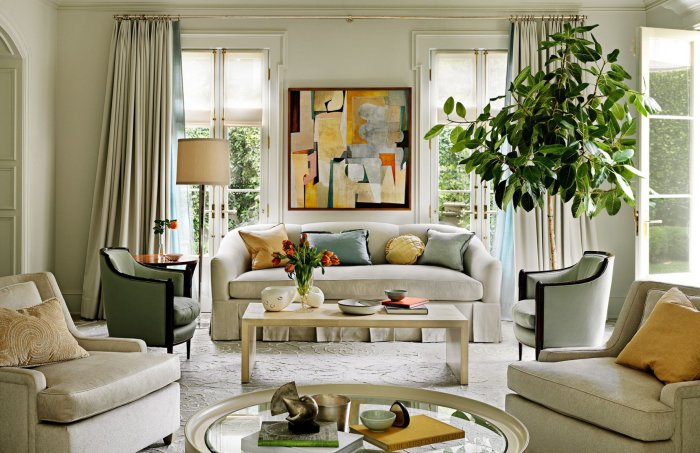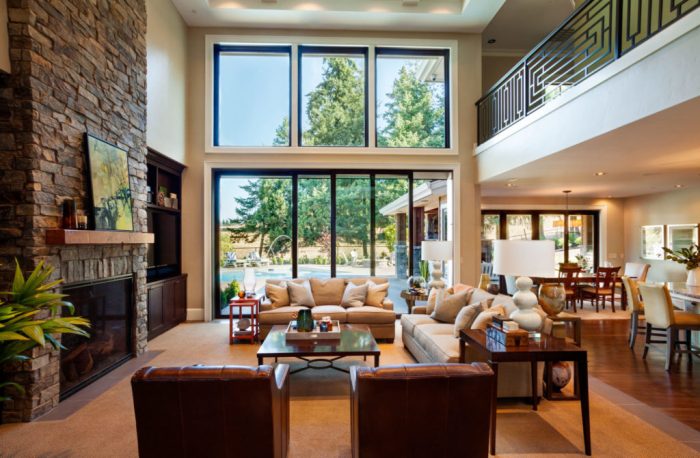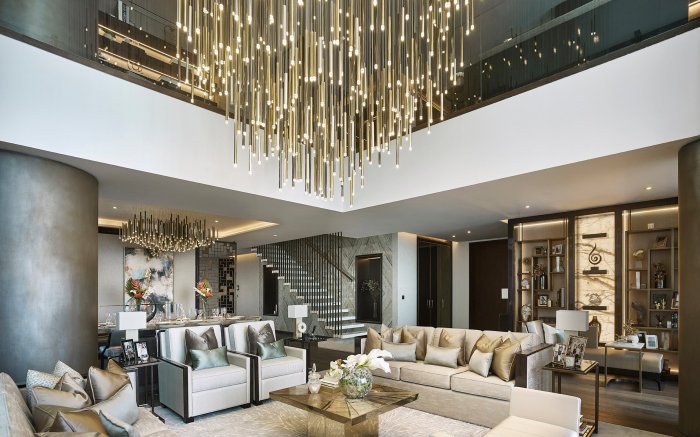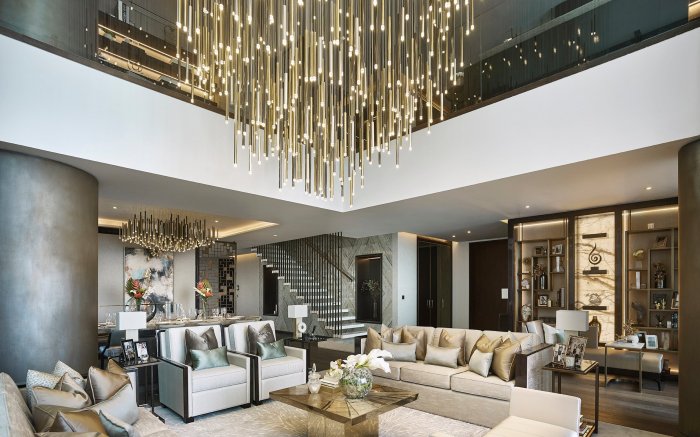American house interior design embodies a rich tapestry of styles, reflecting the nation’s diverse history and evolving tastes. From the classic elegance of Colonial to the rustic charm of Farmhouse, each style offers a unique perspective on home decor, embracing functionality and comfort while showcasing the American spirit.
This guide explores the defining characteristics of American interior design, delving into popular styles, key design elements, furniture choices, and regional variations. We’ll uncover the influence of American design on global trends and peek into the future of this ever-evolving field.
Key Design Elements

American house interior design is characterized by a blend of functionality, comfort, and aesthetics. Key design elements play a crucial role in shaping the overall look and feel of these homes, reflecting the diverse preferences and lifestyles of their inhabitants.
Color Palettes
Color palettes are essential in creating the desired mood and atmosphere within an American house. They can evoke feelings of warmth, sophistication, or tranquility, depending on the chosen hues.
- Neutral Colors:White, gray, beige, and cream are popular choices for American interiors, providing a clean and versatile backdrop for furniture and décor. These colors create a sense of spaciousness and allow for a variety of design styles to be incorporated.
- Warm Colors:Reds, oranges, and yellows are often used to add vibrancy and energy to living spaces. They can create a welcoming and inviting atmosphere, particularly in areas like kitchens and dining rooms.
- Cool Colors:Blues, greens, and purples can evoke feelings of calm and serenity. They are frequently used in bedrooms and bathrooms to promote relaxation and tranquility.
- Accent Colors:Bold colors like turquoise, emerald green, or deep crimson are often used as accents to add pops of color and personality to a neutral palette. These accents can be incorporated through furniture, artwork, or throw pillows.
Materials
The choice of materials is another critical aspect of American house interior design, influencing both the aesthetic and the functionality of the space.
- Wood:Wood is a popular material in American homes, adding warmth, durability, and a touch of rustic charm. It is commonly used for flooring, furniture, cabinets, and beams. Different wood species, such as oak, maple, and cherry, offer unique colors and textures, allowing for diverse design styles.
- Stone:Stone, particularly granite and marble, is often used for countertops, backsplashes, and flooring. These materials add a touch of elegance and sophistication to kitchens and bathrooms. Natural stone also brings a sense of durability and longevity to the home.
- Metal:Metal accents, such as stainless steel, copper, or brass, are frequently incorporated into American interiors. They add a modern and industrial feel, particularly in kitchens and bathrooms. Metal is often used for fixtures, hardware, and furniture accents.
- Textiles:Textiles play a significant role in creating comfort and visual interest in American homes. Fabrics like cotton, linen, wool, and silk are used for upholstery, curtains, rugs, and throw pillows. The choice of fabrics can influence the overall feel of the space, ranging from casual and cozy to formal and elegant.
Lighting
Lighting plays a crucial role in shaping the ambiance of an American house. Proper lighting can enhance the beauty of the interior design, highlight architectural features, and create a welcoming and functional environment.
- Natural Light:Maximizing natural light is a key principle in American house design. Large windows and skylights are often incorporated to flood interiors with sunlight, creating a bright and airy atmosphere. Natural light also contributes to energy efficiency and a sense of connection with the outdoors.
- Artificial Light:Artificial lighting is essential for creating the desired ambiance in different areas of the house.
- Task Lighting:Task lighting, such as under-cabinet lights in kitchens or desk lamps in home offices, provides focused illumination for specific activities.
- Ambient Lighting:Ambient lighting, typically provided by ceiling fixtures or floor lamps, creates a general illumination for the entire room. It sets the overall mood and can be adjusted depending on the desired atmosphere.
- Accent Lighting:Accent lighting, such as track lighting or spotlights, is used to highlight specific features, artwork, or architectural details. It adds depth and dimension to the space and can create a dramatic effect.
Furniture and Decor
Furniture and decor play a crucial role in shaping the overall ambiance and functionality of an American home. From classic styles to contemporary designs, American furniture and decor reflect the diverse tastes and lifestyles of the nation. This section explores popular furniture styles and decor elements commonly found in American homes, focusing on living rooms, bedrooms, and dining rooms.
Living Room Layout
A living room layout is the arrangement of furniture and decor to create a welcoming and functional space for relaxation, entertainment, and social gatherings. American living rooms often feature a mix of styles, blending traditional and modern elements. A popular layout includes a comfortable sofa, armchairs, a coffee table, and an entertainment center.
- Sofa:A large sectional sofa or a traditional three-seater sofa with a chaise lounge provides ample seating for guests and family members.
- Armchairs:Two accent chairs, often upholstered in a contrasting fabric, add visual interest and provide additional seating.
- Coffee Table:A coffee table serves as a focal point for the living room, providing a surface for drinks, snacks, and decorative items.
- Entertainment Center:A media console or entertainment center houses a television, sound system, and other electronic devices.
Decorative elements commonly found in American living rooms include:
- Rugs:Area rugs define the space, add warmth, and complement the furniture.
- Throws and Pillows:Throws and pillows add texture, color, and comfort to the seating area.
- Wall Art:Artwork, photographs, or mirrors add personality and visual interest to the walls.
- Plants:Houseplants bring life and freshness to the living room.
- Lighting:Lamps and overhead lighting create ambiance and illuminate the space.
Bedroom Design
A bedroom is a sanctuary for rest and relaxation. American bedroom design prioritizes comfort and functionality.
American house interior design often prioritizes spaciousness and comfort, but even smaller spaces can be maximized with clever design choices. For those looking to maximize a compact home, 36 sqm house interior design provides inspiring ideas and practical solutions.
These principles can be applied to American homes as well, emphasizing functionality and maximizing every inch of space.
- Bed:A comfortable bed is the centerpiece of the bedroom. Popular choices include king-size or queen-size beds with plush mattresses and headboards.
- Nightstands:Nightstands provide a convenient surface for books, lamps, and other personal items.
- Dresser:A dresser offers ample storage for clothing and accessories.
- Chest:A chest can be used for additional storage or as a decorative element.
American bedrooms often feature a calming color palette and soft textures.
- Window Treatments:Curtains or blinds provide privacy and control light.
- Rugs:A rug adds warmth and defines the seating area.
- Lighting:A bedside lamp provides soft light for reading or relaxing.
- Wall Art:Artwork or photographs can add personality and visual interest to the walls.
Dining Room Space
The dining room is a space for family gatherings and entertaining guests. American dining rooms often feature a traditional dining set with a table and chairs.
- Dining Table:A dining table serves as the focal point of the room. Tables come in various shapes and sizes, from round to rectangular.
- Dining Chairs:Dining chairs should be comfortable and complement the table. Popular styles include upholstered chairs, wooden chairs, and metal chairs.
- Buffet:A buffet provides additional storage for dishes, silverware, and linens.
- China Cabinet:A china cabinet showcases fine china and other decorative items.
American dining rooms often feature warm and inviting decor.
- Tablecloth:A tablecloth adds elegance and protects the table.
- Centerpiece:A centerpiece, such as a vase of flowers or a decorative bowl, adds visual interest to the table.
- Lighting:A chandelier or pendant light illuminates the dining area.
- Wall Art:Artwork or photographs can add personality and visual interest to the walls.
Regional Variations

American house interior design is a diverse tapestry, woven with threads of history, culture, and climate. These factors, along with local architectural traditions, influence the unique styles that emerge across different regions. This diversity is a fascinating aspect of American home design, showcasing the country’s rich cultural landscape.
East Coast Interior Design
The East Coast, steeped in colonial history and traditional architecture, boasts a distinct interior design style. The East Coast style is often characterized by:
- Classic Elegance:This region embraces a timeless elegance, often seen in homes with formal dining rooms, stately living spaces, and a preference for traditional furniture pieces.
- Rich Colors and Textures:Deep jewel tones, rich woods, and luxurious fabrics are commonly used to create a sense of sophistication and grandeur.
- Architectural Details:Homes often feature intricate moldings, fireplaces, and high ceilings, adding to the sense of history and refinement.
West Coast Interior Design
The West Coast, with its laid-back lifestyle and connection to nature, exhibits a distinct interior design style. The West Coast style is often characterized by:
- Modern and Minimalist:West Coast homes often embrace a clean, minimalist aesthetic, with open floor plans, natural light, and a focus on functionality.
- Natural Materials:Wood, stone, and leather are favored materials, creating a sense of warmth and connection to the surrounding environment.
- Coastal Influences:Homes often incorporate nautical elements, such as blue and white color schemes, seashells, and driftwood accents, reflecting the region’s proximity to the ocean.
Southern Interior Design
The South, with its rich history and warm climate, possesses a unique interior design style that reflects its heritage and lifestyle. The Southern style is often characterized by:
- Warm and Inviting:Southern homes often prioritize comfort and hospitality, with welcoming living spaces and a focus on creating a cozy and inviting atmosphere.
- Traditional Elements:Homes often feature traditional furniture pieces, floral patterns, and antique accents, reflecting the region’s historical roots.
- Outdoor Living:The Southern climate encourages outdoor living, with homes often featuring spacious porches, patios, and gardens.
Inspiration and Resources

American house interior design draws inspiration from a rich tapestry of styles, reflecting the country’s diverse history, cultural influences, and evolving tastes. From the grandeur of Colonial mansions to the simplicity of Mid-Century Modern homes, American interior design offers a wealth of inspiration for homeowners seeking to create spaces that are both beautiful and functional.To understand the evolution of American house interior design, it’s essential to explore iconic examples, influential designers, and resources that offer insights into this fascinating field.
American house interior design often embraces a sense of spaciousness and comfort, but what about smaller homes? If you’re working with a limited footprint, a two-story design can be a great solution. Take a look at this 40 sqm house design 2 storey interior for inspiration.
It demonstrates how clever layout and vertical space can create a functional and stylish home, even within a smaller area. While this design might not be the traditional American house, it still showcases the importance of maximizing space and incorporating personal style.
Iconic American Houses and Their Interior Design, American house interior design
Iconic American houses serve as a testament to the country’s architectural and design heritage. These homes, often associated with specific periods or styles, provide valuable insights into the evolution of American interior design. Here are a few notable examples:
- The White House (Washington, D.C.):The official residence of the President of the United States, the White House embodies the grandeur and elegance of Neoclassical architecture. Its interior design features intricate moldings, ornate fireplaces, and a collection of historical furniture and art. The White House’s interior design has evolved over time, reflecting the tastes and preferences of various presidents and their families.
- Fallingwater (Mill Run, Pennsylvania):Designed by Frank Lloyd Wright in 1935, Fallingwater is a masterpiece of modern architecture seamlessly integrated with nature. Its interior design emphasizes natural materials like stone and wood, with open floor plans and large windows that frame stunning views of the surrounding waterfall.
The home’s innovative design and connection to the natural world have inspired generations of architects and designers.
- The Getty Center (Los Angeles, California):Designed by architect Richard Meier, the Getty Center is a stunning example of postmodern architecture. Its interior design features clean lines, minimalist furnishings, and a focus on natural light. The museum’s galleries showcase a collection of European art from the Middle Ages to the present day, highlighting the influence of European design on American interior design.
Influential American Interior Designers
American interior design has been shaped by the contributions of numerous talented designers who have pushed boundaries, introduced new styles, and influenced generations of design professionals. Here are some influential figures:
- Dorothy Draper (1889-1969):Known for her bold use of color, patterns, and whimsical details, Draper revolutionized American interior design in the 1930s and 1940s. She introduced a sense of glamour and sophistication to homes, often using chintz fabrics, floral patterns, and antique furniture.
Draper’s designs are still admired for their timeless elegance and cheerful exuberance.
- Frank Lloyd Wright (1867-1959):A pioneer of modern architecture, Wright’s influence on American interior design is undeniable. He believed in creating spaces that were both functional and beautiful, emphasizing natural materials, open floor plans, and a connection to nature. Wright’s designs, such as Fallingwater and the Guggenheim Museum, continue to inspire architects and designers today.
- Elsie de Wolfe (1865-1950):A pioneer of interior design, de Wolfe is credited with bringing a sense of style and sophistication to American homes in the early 20th century. She introduced the concept of using white as a neutral backdrop for colorful accents, and she favored simple, elegant furniture.
De Wolfe’s designs emphasized comfort and functionality, and she is considered a founding figure in the profession of interior design.
Books, Websites, and Magazines
For those seeking to delve deeper into American house interior design, numerous resources offer valuable insights and inspiration.
- Books:
- “American Houses: A Celebration of a Century of Design” by Michael Adams and Virginia McAlester: This comprehensive book provides a detailed overview of American house design from the late 19th century to the present day.
- “The Interior Design Handbook: A Comprehensive Guide to Planning, Decorating, and Furnishing” by Jane Schmookler: This practical guide offers a step-by-step approach to designing and decorating your home, with tips on everything from space planning to choosing furniture and accessories.
- “American Interiors: A Century of Style” by Victoria Hagan: This book explores the evolution of American interior design through a collection of stunning photographs and insightful commentary.
- Websites:
- Architectural Digest:This website features articles, photo galleries, and videos on a wide range of design topics, including American house interior design.
- Elle Decor:Elle Decor offers a curated selection of design inspiration, featuring articles on interior design, architecture, and lifestyle.
- Houzz:Houzz is a popular website and app that allows users to browse photos of homes and connect with design professionals.
- Magazines:
- House Beautiful:House Beautiful offers a mix of design inspiration, practical advice, and product recommendations for homeowners.
- Veranda:Veranda features a sophisticated approach to design, showcasing luxurious homes and stylish interiors.
- Traditional Home:Traditional Home focuses on classic and timeless design, featuring articles on traditional architecture, furniture, and decor.
Concluding Remarks
Whether you’re seeking inspiration for your own home or simply curious about the evolution of American design, this exploration offers a glimpse into the heart of American home decor. By understanding the key elements, styles, and trends, you can create a space that reflects your personal taste while embracing the enduring spirit of American interior design.
General Inquiries: American House Interior Design
What are some common materials used in American house interior design?
Wood, stone, metal, and textiles are frequently used materials in American interiors, reflecting a focus on natural elements and durability.
How can I incorporate American design elements into my existing home?
Start with a color palette inspired by nature, use wood furniture or accents, and consider incorporating traditional American patterns like gingham or floral prints.
What are some popular American furniture styles?
Some popular American furniture styles include Colonial, Shaker, Mission Revival, and Arts & Crafts.
What is the significance of lighting in American house interior design?
Lighting plays a crucial role in setting the mood and ambiance of an American home. Natural light is often prioritized, while decorative fixtures add character and style.




